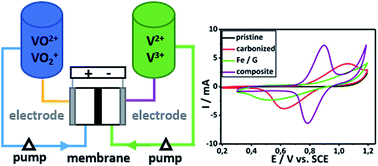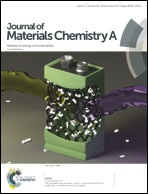Salt-templated porous carbon–carbon composite electrodes for application in vanadium redox flow batteries†
Abstract
The catalytic graphitization procedure was optimized by impregnating polyacrylonitrile-based felts with iron(III) chloride solution (0.5 wt% Fe) as the catalyst. By this approach, the graphitization temperature of the felts was reduced to 1000 °C and below. This allowed retaining higher nitrogen contents in the felts, most probably enhancing their electrocatalytic activity for utilization in redox flow batteries. Moreover, lower process temperatures will reduce the production costs of carbon felt (CF) electrodes in the future. Combining the catalytic graphitization with a salt-templating step, porous carbon–carbon composite electrodes with a 100 times increased surface area (126 m2 g−1) were obtained. The structure, graphitization degree and porosity were characterized using X-ray diffraction (XRD), X-ray photoelectron spectroscopy (XPS), scanning electron microscopy (SEM), and nitrogen sorption (BET), whereas the electrochemical performance of the composite electrodes for application in all-vanadium redox flow batteries was evaluated by cyclic voltammetry (CV).



 Please wait while we load your content...
Please wait while we load your content...